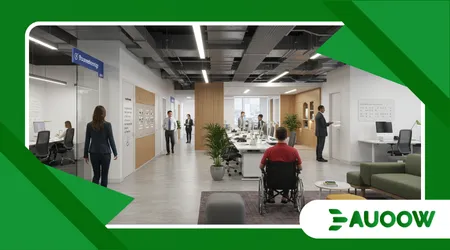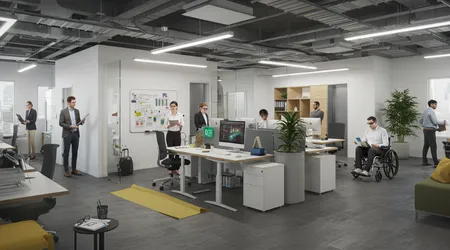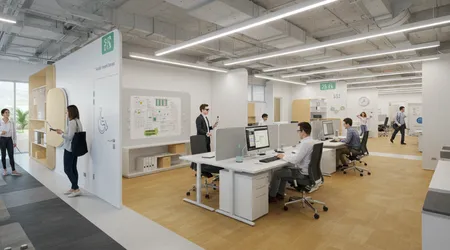Accessible Office Design: Beyond Ramps and Elevators

Accessible Office Design is no longer just about compliance it’s about creating inclusive workplaces that empower everyone.
In 2025, businesses are rethinking office spaces to foster equity, productivity, and belonging. Gone are the days when accessibility meant only ramps and elevators.
Today, it’s about holistic design that considers diverse needs physical, sensory, and cognitive. Why settle for bare-minimum compliance when you can build a workplace that truly welcomes all?
This article explores how Accessible Office Design transforms workplaces, with practical examples, real data, and innovative strategies.
The modern workforce is diverse, spanning generations, abilities, and work styles. Companies prioritizing Accessible Office Design see higher employee satisfaction and retention.
According to a 2023 study by the World Health Organization, 16% of the global population lives with a disability, yet many offices remain ill-equipped.
Inclusive design isn’t just ethical it’s a business advantage. From adjustable desks to sensory-friendly spaces, Accessible Office Design drives innovation and reflects a company’s commitment to its people.
The Evolution of Workplace Accessibility
Accessibility in offices once focused on physical barriers. Ramps and elevators addressed mobility but ignored other needs. Accessible Office Design now encompasses a broader spectrum.
It includes neurodiversity, sensory sensitivities, and mental health. For example, a tech startup in São Paulo redesigned its open-plan office with quiet pods for neurodivergent employees, boosting focus and reducing stress.
Modern Accessible Office Design integrates universal design principles. These prioritize flexibility and usability for all, regardless of ability. Think of it like a smartphone: one device adapts to countless users.
++ Top 10 Companies Leading in Disability Inclusion Hiring
Features like voice-activated controls or braille signage aren’t just for specific groups they enhance everyone’s experience. Companies adopting this approach report improved collaboration and innovation.
Another shift is technology’s role in accessibility. Smart lighting adjusts to reduce eye strain, while AI-driven tools offer real-time captioning.
A 2024 case study from Google’s accessibility team showed that inclusive tech increased team productivity by 12%. Accessible Office Design is about creating spaces where everyone thrives, not just survives.

Designing for Physical Accessibility
Physical accessibility remains foundational in Accessible Office Design. Beyond ramps, offices need wider doorways, adjustable furniture, and clear navigation paths.
For instance, a London-based law firm installed height-adjustable desks, allowing wheelchair users and standing workers to customize their setups seamlessly.
Ergonomics plays a critical role. Chairs with lumbar support and desks with tilt options reduce strain for all employees. Navigation aids, like tactile floor guides, help visually impaired workers move confidently. These features aren’t just add-ons they’re integral to a functional workspace.
Also read: AI lowering barriers for disabled entrepreneurs
Consider the cost-benefit. A 2023 U.S. Access Board report estimated that retrofitting offices for accessibility costs 20% less than legal penalties for non-compliance.
Investing in Accessible Office Design upfront saves money and builds a reputation for inclusivity. It’s a win-win that forward-thinking companies can’t ignore.
Sensory-Friendly Workspaces
Sensory overload is a hidden barrier in many offices. Bright lights, loud HVAC systems, or crowded open-plan layouts can overwhelm employees with sensory sensitivities.
Accessible Office Design tackles this with intentional choices. For example, a Sydney marketing agency installed acoustic panels and dimmable lights, creating a calmer environment for all.
Natural light is a game-changer. Studies show it boosts mood and productivity. Offices can use adjustable blinds to balance light without glare.
Quiet zones with noise-canceling technology also help. These spaces allow employees to recharge, especially those with autism or anxiety.
Read more: Global Market Opportunities for Entrepreneurs: Leveraging International Trends and Innovations
Scent and air quality matter too. Fragrance-free policies and high-quality air filters reduce triggers for employees with chemical sensitivities.
By prioritizing sensory-friendly elements, Accessible Office Design ensures everyone can focus and perform at their best.
Cognitive and Neurodiverse Considerations
Not all disabilities are visible. Cognitive and neurodiverse employees like those with ADHD or dyslexia benefit from tailored environments.
Accessible Office Design incorporates clear signage, color-coded spaces, and distraction-free zones. A New York co-working space, for instance, uses color-coded zones to guide employees intuitively.
Flexible work arrangements are key. Offering hybrid options or adjustable schedules accommodates diverse cognitive needs.
Tools like text-to-speech software or simplified interfaces also help. These solutions don’t just support neurodiverse employees they enhance efficiency for everyone.
Training staff on inclusivity is equally important. A 2024 LinkedIn survey found that 68% of employees value workplaces with neurodiversity training.
By fostering understanding, companies create a culture where Accessible Office Design thrives, benefiting morale and productivity.
Technology as an Accessibility Enabler
Technology is revolutionizing Accessible Office Design. AI-powered tools, like real-time captioning for meetings, ensure deaf employees stay engaged.
Smart thermostats and voice-activated controls empower those with mobility challenges. A Seattle tech firm reported a 15% engagement boost after implementing these tools.
Wearable devices are emerging as game-changers. For example, haptic feedback wearables guide visually impaired employees through office layouts.
Cloud-based platforms also allow remote collaboration, leveling the playing field for hybrid teams. Technology makes accessibility seamless and scalable.
However, tech must be user-friendly. Overly complex systems can alienate employees. Simple interfaces and regular training ensure everyone benefits.
Accessible Office Design leverages technology to empower, not exclude, creating a workplace where innovation flourishes.
The Business Case for Accessibility

Investing in Accessible Office Design isn’t just ethical it’s smart business. Inclusive workplaces attract top talent. A 2023 Deloitte study found that 80% of job seekers prioritize inclusive employers. Accessibility also reduces turnover, saving recruitment costs.
Legal compliance is another driver. In the U.S., the ADA mandates accessible workplaces, with non-compliance fines reaching $75,000. Proactive design avoids these costs. Plus, accessible offices appeal to clients who value social responsibility, enhancing brand reputation.
Consider this analogy: an accessible office is like a well-designed bridge. It doesn’t just connect two points it ensures everyone can cross safely and efficiently. By prioritizing Accessible Office Design, companies build stronger, more resilient teams.
Table: Key Elements of Accessible Office Design
| Feature | Benefit | Example |
|---|---|---|
| Adjustable Furniture | Enhances comfort for all employees | Height-adjustable desks |
| Sensory-Friendly Lighting | Reduces sensory overload | Dimmable LED lights |
| Clear Signage | Improves navigation for all | Braille and color-coded signs |
| Quiet Zones | Supports focus and mental health | Soundproof pods |
| AI Captioning Tools | Ensures inclusive communication | Real-time meeting transcription |
Practical Steps for Implementation
Start small but think big. Conduct an accessibility audit to identify gaps. Engage employees for feedback those with disabilities often have the best insights. A Chicago startup did this, uncovering the need for better lighting and quieter meeting rooms.
Partner with experts. Accessibility consultants can recommend tailored solutions, from ergonomic furniture to tech integrations. Budget for phased upgrades to spread costs. Training staff on inclusive practices ensures long-term success.
Finally, measure impact. Track employee satisfaction and productivity post-implementation. A 2024 SHRM study showed that inclusive offices saw a 22% rise in engagement. Accessible Office Design isn’t a one-time fix it’s an ongoing commitment to equity.
Overcoming Common Challenges
Implementing Accessible Office Design isn’t without hurdles. Budget constraints often top the list. Small businesses may hesitate due to perceived costs. However, modular solutions like adjustable desks are affordable and scalable.
Resistance to change is another issue. Some employees may view accessibility upgrades as unnecessary. Clear communication about benefits like improved productivity can shift mindsets. Leadership buy-in is crucial for driving change.
Retrofit challenges in older buildings can also arise. Narrow hallways or outdated elevators require creative solutions. For example, a Paris office used portable ramps and modular furniture to adapt without major renovations. Persistence pays off.
Cultural Shift Toward Inclusion
Accessibility isn’t just about physical changes it’s a mindset. Accessible Office Design thrives in cultures that prioritize empathy. Training programs on disability awareness foster understanding. A 2024 Harvard study found inclusive cultures boost retention by 30%.
Celebrate small wins. Recognize employees who champion accessibility, like a team that redesigned a breakroom for wheelchair access. These stories inspire others. An inclusive culture turns Accessible Office Design into a shared mission.
Leadership sets the tone. When executives model inclusivity, it cascades through the organization. Regular feedback loops ensure employees feel heard. A workplace that values every voice is one where accessibility flourishes.
FAQs: Accessible Office Design
What is Accessible Office Design?
It’s the practice of creating workplaces that accommodate diverse physical, sensory, and cognitive needs, ensuring inclusivity for all employees.
How much does it cost to implement Accessible Office Design?
Costs vary, but modular solutions like adjustable desks are affordable. Retrofitting may cost 20% less than legal penalties, per the U.S. Access Board.
Can small businesses afford Accessible Office Design?
Yes, phased upgrades and scalable solutions like portable ramps make it feasible. Employee feedback helps prioritize cost-effective changes.
Why is sensory-friendly design important?
It reduces overload for employees with sensory sensitivities, boosting focus and well-being for all, as seen in offices with dimmable lights.
How does technology enhance accessibility?
AI tools like real-time captioning and smart controls improve communication and navigation, making offices inclusive and efficient for everyone.
